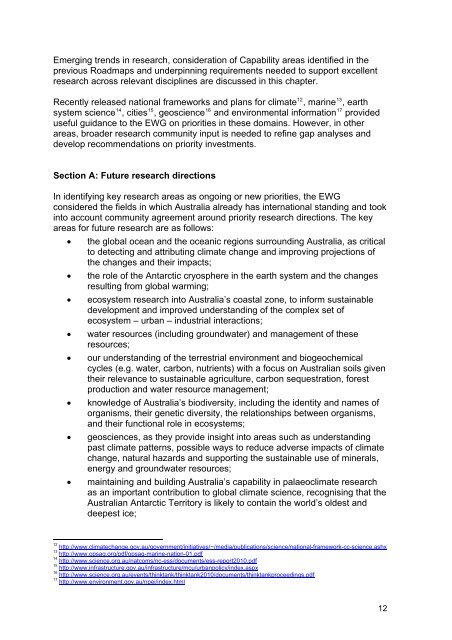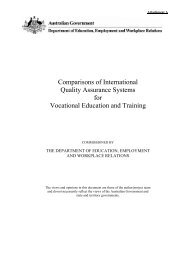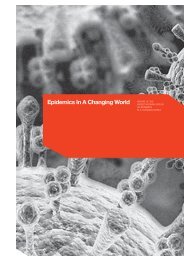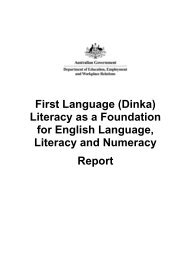2011 Strategic Roadmap for Australian Research Infrastructure
2011 Strategic Roadmap for Australian Research Infrastructure
2011 Strategic Roadmap for Australian Research Infrastructure
You also want an ePaper? Increase the reach of your titles
YUMPU automatically turns print PDFs into web optimized ePapers that Google loves.
Emerging trends in research, consideration of Capability areas identified in the<br />
previous <strong>Roadmap</strong>s and underpinning requirements needed to support excellent<br />
research across relevant disciplines are discussed in this chapter.<br />
Recently released national frameworks and plans <strong>for</strong> climate 12 , marine 13 , earth<br />
system science 14 , cities 15 , geoscience 16 and environmental in<strong>for</strong>mation 17 provided<br />
useful guidance to the EWG on priorities in these domains. However, in other<br />
areas, broader research community input is needed to refine gap analyses and<br />
develop recommendations on priority investments.<br />
Section A: Future research directions<br />
In identifying key research areas as ongoing or new priorities, the EWG<br />
considered the fields in which Australia already has international standing and took<br />
into account community agreement around priority research directions. The key<br />
areas <strong>for</strong> future research are as follows:<br />
the global ocean and the oceanic regions surrounding Australia, as critical<br />
to detecting and attributing climate change and improving projections of<br />
the changes and their impacts;<br />
the role of the Antarctic cryosphere in the earth system and the changes<br />
resulting from global warming;<br />
ecosystem research into Australia’s coastal zone, to in<strong>for</strong>m sustainable<br />
development and improved understanding of the complex set of<br />
ecosystem – urban – industrial interactions;<br />
water resources (including groundwater) and management of these<br />
resources;<br />
our understanding of the terrestrial environment and biogeochemical<br />
cycles (e.g. water, carbon, nutrients) with a focus on <strong>Australian</strong> soils given<br />
their relevance to sustainable agriculture, carbon sequestration, <strong>for</strong>est<br />
production and water resource management;<br />
knowledge of Australia’s biodiversity, including the identity and names of<br />
organisms, their genetic diversity, the relationships between organisms,<br />
and their functional role in ecosystems;<br />
geosciences, as they provide insight into areas such as understanding<br />
past climate patterns, possible ways to reduce adverse impacts of climate<br />
change, natural hazards and supporting the sustainable use of minerals,<br />
energy and groundwater resources;<br />
maintaining and building Australia’s capability in palaeoclimate research<br />
as an important contribution to global climate science, recognising that the<br />
<strong>Australian</strong> Antarctic Territory is likely to contain the world’s oldest and<br />
deepest ice;<br />
12<br />
http://www.climatechange.gov.au/government/initiatives/~/media/publications/science/national-framework-cc-science.ashx<br />
13<br />
http://www.opsag.org/pdf/opsag-marine-nation-01.pdf<br />
14<br />
http://www.science.org.au/natcoms/nc-ess/documents/ess-report2010.pdf<br />
15<br />
http://www.infrastructure.gov.au/infrastructure/mcu/urbanpolicy/index.aspx<br />
16<br />
http://www.science.org.au/events/thinktank/thinktank2010/documents/thinktankproceedings.pdf<br />
17<br />
http://www.environment.gov.au/npei/index.html<br />
12
















